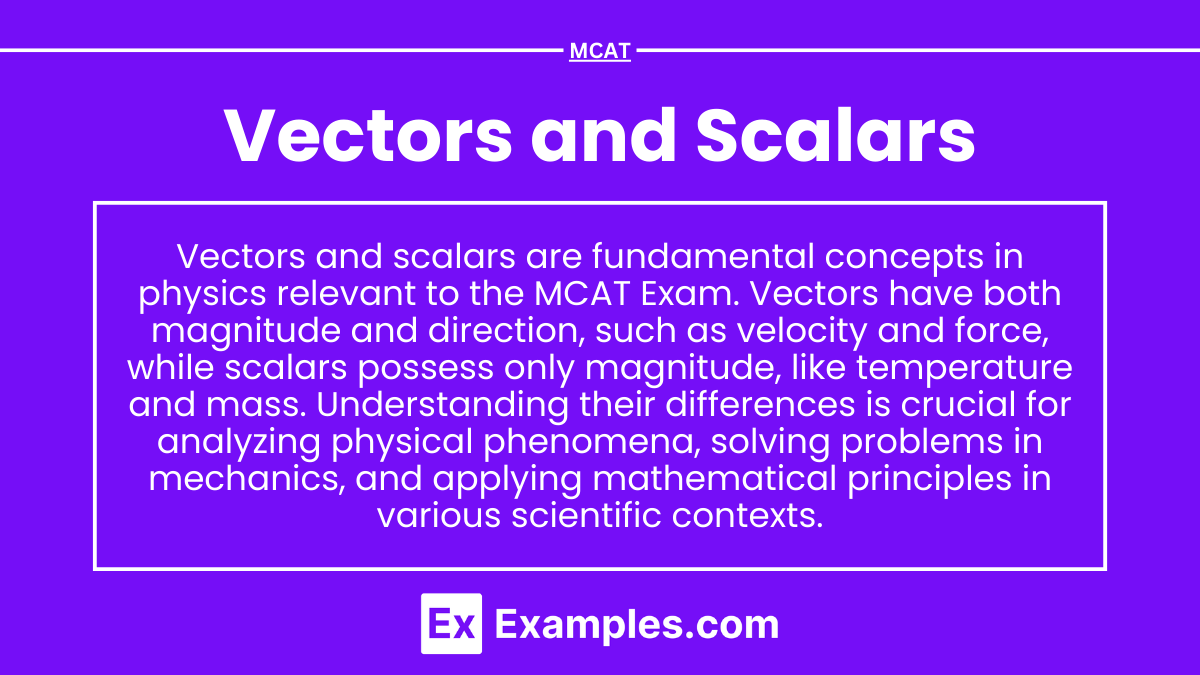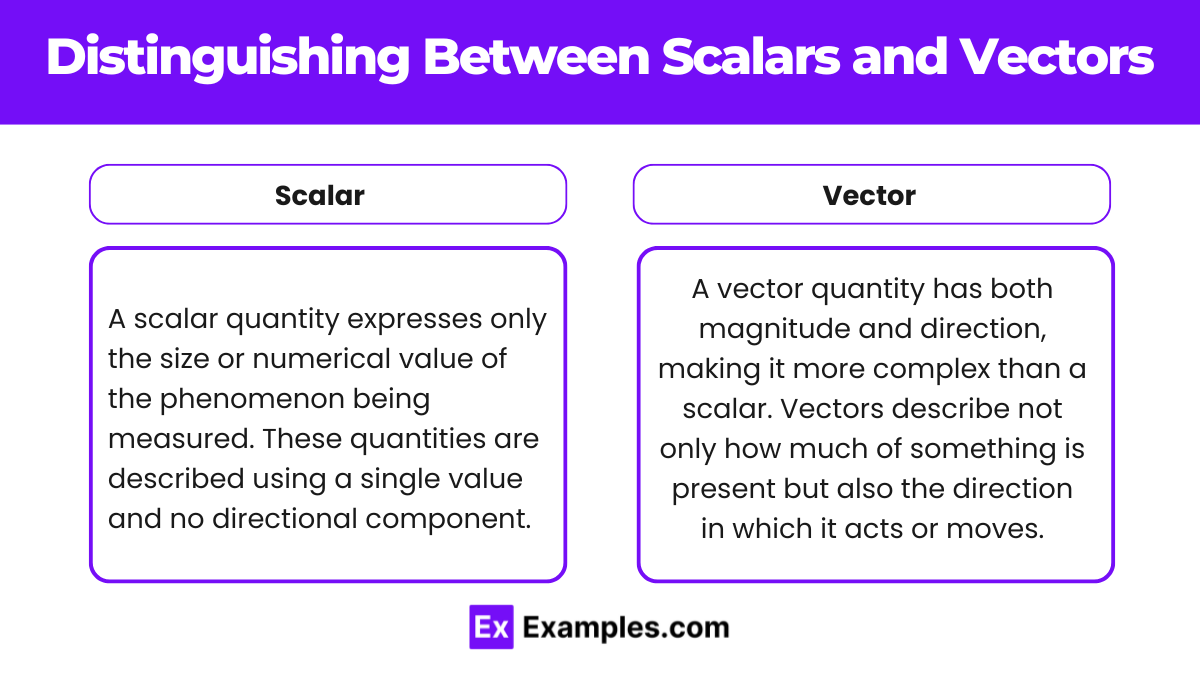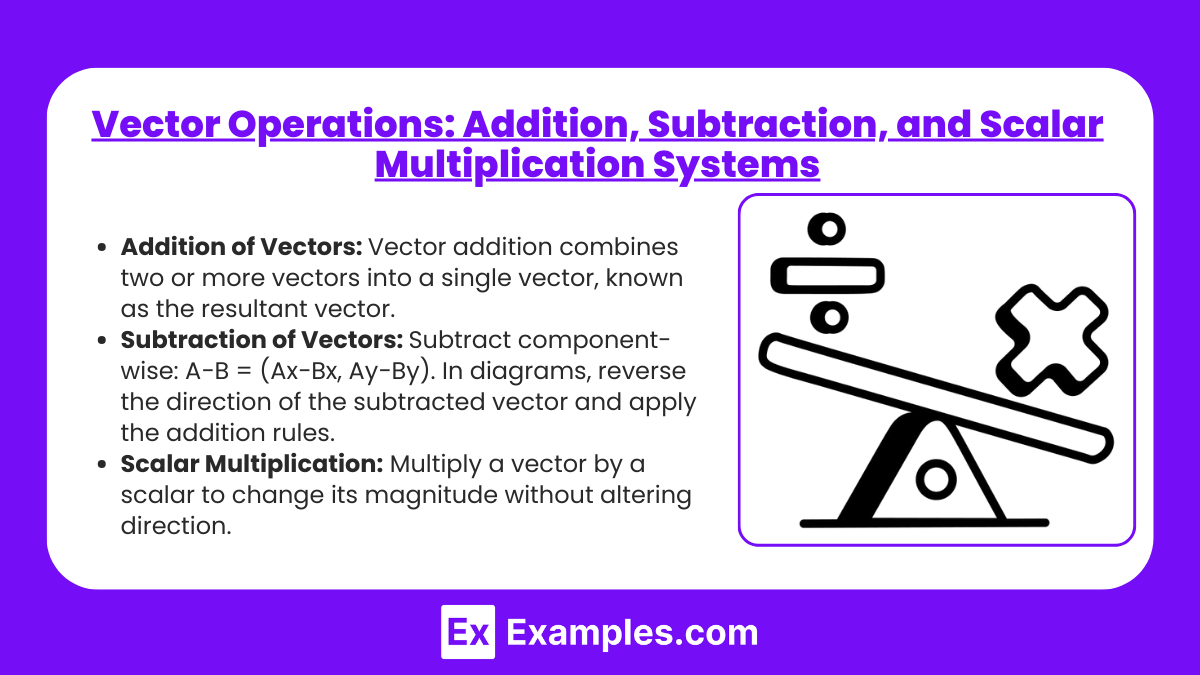Vectors and scalars are fundamental to physics, playing a key role in describing motion, forces, and other physical quantities. On the MCAT, you’ll explore vector and scalar quantities, their differences, and how they are used in problem-solving. Understanding vector operations, such as addition and subtraction, along with scalar products, is crucial, as these concepts are key to mastering mechanics and kinematics sections of the exam.
Learning Objectives
In studying "Vectors and Scalars" for the MCAT, you should learn to distinguish between scalar quantities, which have magnitude only, and vector quantities, which include both magnitude and direction. Understand how to perform vector operations such as addition, subtraction, and scalar multiplication, both graphically and analytically. Practice resolving vectors into their components using trigonometric functions. Analyze physical scenarios involving displacement, velocity, acceleration, and force to apply vector concepts effectively. Evaluate the use of unit vectors and understand the importance of vector notation in solving multi-dimensional problems. Additionally, develop proficiency in identifying when to use scalar vs. vector quantities in physics-related MCAT questions.
Distinguishing Between Scalars and Vectors
Scalar
A scalar quantity expresses only the size or numerical value of the phenomenon being measured. These quantities are described using a single value and no directional component.
Properties of Scalars
Scalars can be positive or negative.
Only arithmetic operations (addition, subtraction, multiplication, and division) are used for calculations involving scalars.
Scalars are not affected by direction.
Examples of Scalars
Temperature: 25°C (the measurement is independent of direction).
Mass: 70 kg (the mass of an object remains constant regardless of where it is).
Time: 15 seconds (time always progresses without directional relevance).
Speed: 60 km/h (only shows how fast something moves, not the direction).
Vector
A vector quantity has both magnitude and direction, making it more complex than a scalar. Vectors describe not only how much of something is present (magnitude) but also the direction in which it acts or moves.
Properties of Vectors
Vectors require both magnitude and direction to be fully described.
They are often represented with an arrow:
Length of the arrow = magnitude of the vector.
Direction of the arrow = the direction in which the vector acts.
Vectors require specific rules for addition and multiplication, such as the triangle or parallelogram method.
Examples of Vectors
Displacement: 100 meters east (shows the distance and direction).
Velocity: 80 km/h northward (speed with a directional component).
Force: 30 N upward (force has both a magnitude and a specific direction).
Acceleration: 9.8 m/s² downward (acceleration due to gravity acts toward Earth’s center).
Key Differences Between Scalars and Vectors
Aspect | Scalar | Vector |
Magnitude | Only magnitude | Magnitude and direction |
Direction | No direction | Has a specific direction |
Examples | Mass, time, speed, temperature | Velocity, force, displacement |
Mathematical Operations | Standard arithmetic | Vector addition and multiplication |
Graphical Representation | Not applicable | Arrow with length and direction |
Vector Operations: Addition, Subtraction, and Scalar Multiplication
Addition of Vectors:
Use tip-to-tail method: Place the tail of the second vector at the tip of the first. The resulting vector goes from the tail of the first to the tip of the second.
Use parallelogram rule: Arrange the vectors to form a parallelogram, and the diagonal represents the sum.
Component-wise Addition Example:
A = (3, 4), B=(1,−2)
A+B = (3+1, 4−2) = (4, 2)
Subtraction of Vectors: Subtract component-wise: A−B = (Ax−Bx, Ay−By). In diagrams, reverse the direction of the subtracted vector and apply the addition rules.
Scalar Multiplication: Multiply a vector by a scalar to change its magnitude without altering direction.
If A = (2, 3), and scalar k = 2,
kA = 2(2, 3) = (4,6).
If k is negative, the vector's direction reverses.
Application of Vector Concepts in Physical Scenarios
Displacement: The straight-line distance between two points with direction. Example: Walking 10 meters north is displacement, while the same distance covered in any random direction would only give distance (a scalar).
Velocity vs. Speed: Speed is scalar, whereas velocity specifies both speed and direction. A car moving at 60 km/h northeast has a specific velocity, while 60 km/h without direction indicates speed.
Acceleration: A vector that indicates the rate of change of velocity. Negative acceleration (deceleration) reduces velocity magnitude.
Force: All forces are vector quantities and are governed by Newton’s laws. Understanding the net force using vector addition is critical in multi-force scenarios such as equilibrium problems.
MCAT Insight: Look for phrases such as "direction of motion" or "net force" in questions to determine if vector analysis is required.
Using Unit Vectors and Vector Notation
A vector is a quantity that has both magnitude and direction. Resolving a vector into components means breaking it down into parts that align with the coordinate axes, typically the x and y axes in a 2D space.
Steps to Resolve a Vector:
Identify the Angle: Determine the angle the vector makes with the horizontal axis (x-axis). This angle is often given in the problem or can be calculated based on vector coordinates.
Magnitude of the Vector: Know the magnitude (length) of the vector.
Trigonometric Functions: Use the sine and cosine functions to find the components:
Horizontal Component (x): The magnitude of the vector multiplied by the cosine of the angle θ. x = rcos(θ).
Vertical Component (y): The magnitude of the vector multiplied by the sine of the angle θ. y = rsin(θ).
Example:
Suppose a vector has a magnitude of 10 units and makes an angle of 30 degrees with the x-axis. To find the components:
Horizontal Component (x): x = 10cos(30∘) = 10×0.866 = 8.66 units.
Vertical Component (y): y = 10sin(30∘) = 10×0.5 = 5 units.
These components tell you how much of the vector is pointing in the horizontal direction and how much is pointing in the vertical direction, allowing you to fully describe the vector's direction and magnitude in terms of the axes.
Identifying When to Use Scalar vs. Vector Quantities
When to Use Scalars: Scalars simplify calculations where direction is not important. For example:
Calculating kinetic energy: K.E.= 1/2mv2 (only magnitude matters).
Finding work done by a constant force along a path: W = Fdcosθ (direction only affects cosine component).
When to Use Vectors: Use vector quantities when both magnitude and direction influence the outcome:
Finding Net Force: Combine forces in different directions using vector addition.
Projectile Motion: Resolve the initial velocity into horizontal and vertical components to analyze flight time and range.
MCAT Tip: Pay attention to whether the problem requires only the magnitude (scalar) or both magnitude and direction (vector). For example, if the problem asks for "total distance," it is scalar, but if it asks for "net displacement," it is vector.
Examples
Example 1: Distance (Scalar) vs. Displacement (Vector)
Distance: A scalar quantity representing the total path length traveled, regardless of direction. For example, if you walk 3 meters forward and 3 meters back, the total distance covered is 6 meters.
Displacement: A vector quantity that measures the shortest straight-line distance from the initial to the final position, including direction. In the previous example, the displacement is 0 meters, since you returned to the starting point.
Example 2: Speed (Scalar) vs. Velocity (Vector)
Speed: The rate at which an object covers distance, expressed in units such as meters per second (m/s). It only has magnitude (e.g., 20 m/s).
Velocity: The rate of change of displacement over time, including direction. A car moving at 20 m/s north has a specific velocity. If the direction changes, the velocity changes even if the speed remains the same.
Example 3: Mass (Scalar) vs. Weight (Vector)
Mass: A scalar quantity representing the amount of matter in an object, measured in kilograms (kg). Mass does not depend on direction or location.
Weight: A vector quantity that represents the gravitational force acting on an object. It points toward the center of the Earth (or any gravitational source) and is calculated as W=mgW = mgW=mg, where ggg is the acceleration due to gravity.
Example 4: Energy (Scalar) vs. Force (Vector)
Energy: A scalar quantity, such as kinetic or potential energy, representing the ability to do work. For example, a moving object with 50 Joules of kinetic energy has only a magnitude.
Force: A vector quantity that causes an object to accelerate. For example, a force of 10 Newtons acting to the right will change an object’s motion in that direction. Forces are often resolved into components along different axes.
Example 5: Temperature (Scalar) vs. Acceleration (Vector)
Temperature: A scalar quantity that measures the average kinetic energy of particles in a substance. It only has magnitude and is measured in degrees Celsius or Kelvin.
Acceleration: A vector quantity representing the rate of change of velocity. For instance, an object accelerating at 5 m/s² upward not only provides how fast the velocity changes but also specifies the direction of that change.
Practice Questions
Question 1:
Which of the following quantities is a vector?
A) Mass
B) Distance
C) Force
D) Temperature
Correct Answer: C) Force
Explanation:
Mass is a scalar because it only has magnitude and no direction.
Distance is a scalar that measures the total path length traveled without considering direction.
Temperature is also a scalar because it only reflects the magnitude of heat energy.
Force is a vector because it requires both magnitude (how strong the force is) and direction (which way it is applied). Vector quantities like force are crucial for determining the effect of interactions between objects.
Question 2:
An object is thrown upward with a velocity of 10 m/s. Which of the following describes the velocity at the highest point?
A) 10 m/s upward
B) 10 m/s downward
C) 0 m/s
D) 9.8 m/s downward
Correct Answer: C) 0 m/s
Explanation:
At the highest point of the motion, the object momentarily stops moving before reversing direction and falling downward, meaning its velocity is 0 m/s. Although gravity is acting downward, causing an acceleration of 9.8 m/s², velocity refers to the rate of displacement, which at that instant is zero. This question highlights the distinction between velocity (vector) and speed during different phases of motion.
Question 3:
A car travels 5 km east, then 5 km west. What is the car’s displacement?
A) 10 km
B) 0 km
C) 5 km
D) 25 km
Correct Answer: B) 0 km
Explanation:
Displacement is a vector quantity that measures the shortest straight-line distance between the starting point and the final point, including direction. In this case, the car returns to its starting point after traveling east and then west, so the net displacement is 0 km. Although the total distance covered (a scalar) is 10 km, displacement considers direction, resulting in a net displacement of zero.





